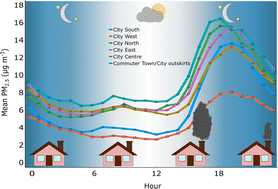Highly local sources and large spatial variations in PM2.5 across a city: evidence from a city-wide sensor network in Cork, Ireland†
Abstract
When dominated by local emissions, levels of ambient particulate matter (PM) can vary appreciably within a city. In Ireland, residential solid fuel burning is the main PM2.5 emission source. As a result, smoke from a small number of chimneys can have a major impact on the air quality in the surrounding area. The emergence of low-cost air quality sensors has enabled researchers to quantify this variation with high spatial density and high temporal resolution. In this study, a network of 16 PurpleAir (PA) devices measured PM2.5 over a one-year period in Cork city, Ireland. Raw measurements were corrected based on the relationship between a co-located PA device and a reference instrument, and the influence of temperature and relative humidity were also accounted for. Hourly corrected data showed significant spatial variation across Cork city, with some areas experiencing daily average peaks approximately double that of others. Significant pollution periods occurred across the different location types (city centre, areas surrounding the city centre, and commuter towns) causing infrequent exposure to high PM2.5 concentrations. The seasonal variation was consistent across all locations, with higher variation seen in winter compared to summer diurnal profiles. The winter months displayed a characteristic evening peak in PM2.5 associated with the use of solid fuel for home heating. High frequency (two-minute timescale) data was analysed in a novel way to classify and quantify local sources and non-local sources of particulate emissions. Short-lived spikes in PM were found to likely be from highly local sources, such as individual chimneys in the vicinity of the sensor. These characteristic spikes indicated the impact of highly local sources and short episodes of extreme air pollution. The classification estimates corroborated the spatial variation found and showed some devices were exposed to local emissions for 40–50% of the period analysed, while for others this contribution was below 20%.

- This article is part of the themed collections: Outstanding Papers 2023 – Environmental Science: Atmospheres and A collection on dense networks and low-cost sensors, including work presented at ASIC 2022


 Please wait while we load your content...
Please wait while we load your content...